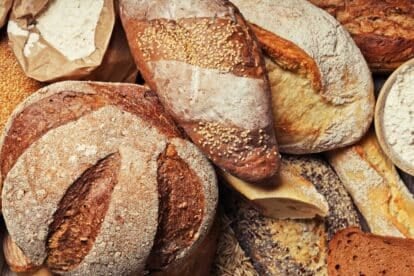Do you have IBS-like flare-ups after eating sweets made with regular white sugar, starches, and other foods like oranges, bananas, and cantaloupe (when these are low FODMAP choices)?
You may need to park right here for a moment, and consider a lesser known issue called Sucrase Isomaltase Deficiency.
What is Sucrase-Isomaltase Deficiency?

Sucrase-isomaltase deficiency (SID) is a condition where the body lacks or has reduced activity of the enzymes sucrase, maltase, and isomaltase (also called palatinase) that are essential for digesting sucrose (a specific type of sugar), maltose, and isomaltose (found in starches).
This deficiency hinders the breakdown of these sugars into simpler forms for absorption, leading to digestive issues.
Living with sucrase-isomaltase deficiency can present unique dietary challenges and require careful management. This article covers need-to-know info about SID, from understanding the condition and its symptoms to exploring diet and treatment options, including enzyme supplements. Let’s dive in!
Types of SID
First, let’s look at the two types of SID:
- Congenital Sucrase-Isomaltase Deficiency (CSID): A genetic condition present from birth, often diagnosed in infants and young children.
- Acquired Sucrase-Isomaltase Deficiency (ASID): Can develop in adults, often associated with other gastrointestinal issues or damage to the small intestine (such as in unmanaged celiac disease, gastrointestinal infection, and/or SIBO/ISO/IMO for example).
A new term has been proposed to combine the above terms, called Genetic Sucrase-Isomaltase Deficiency (GSID), as it recognizes the genetic mutations that can affect enzyme production, and also the fact that SID symptoms may not manifest in a person until later in life.
*Note: The terms SID, CSID, ASID, and GSID will be used interchangeably in this article.
Who is Affected?

GSID can affect both children and adults, and symptoms often overlap with those of irritable bowel syndrome (IBS), and maybe higher in Greenland Eskimos (an estimated 10% in this population!).
Interestingly, about 25-30% of individuals with IBS-D and IBS-M may actually have undiagnosed disaccharide enzyme deficiencies. (Learn more about IBS Subtypes!)
For more detailed info on how to approach IBS-D or IBS-M, feel free to grab a free mini guide here.
Recognizing the Symptoms
Not everyone with SID has the exact same symptoms; however, symptoms patients can experience may include:
- Diarrhea
- Abdominal pain & cramping
- Bloating
- Excessive gas
- Nausea
- Early satiety (fullness)
- Indigestion
- Weight loss, particularly in those with pan-disaccharidase deficiency (meaning all enzymes listed above, plus lactase, the enzyme needed to digest the sugar lactose, found in larger amounts in “wet” forms of dairy like milk, ice cream and yogurt, are not working at optimal efficiency)
Diagnosing SID
Diagnosing SID can involve:
- Duodenal Biopsy: This is the gold standard for diagnosis, involving examination of small intestine tissue (specifically the third part of the duodenum) for enzyme activity; however, it’s only available in certain countries.
- Genetic Testing: Detects polymorphisms in the sucrase-isomaltase (SI) gene using buccal swab, saliva, or blood samples
- Breath Testing: A non-invasive alternative that measures hydrogen levels after sucrose ingestion, though it’s less precise (see the point on SIBO at the end of this article)
- Sucrose Challenge: A simple test but not validated, involving ingestion of sucrose to provoke symptoms.
Enzymes Tested
- Lactase
- Sucrase
- Maltase
- Isomaltase (also referred to as Palatinase)
Cut-off Values for Enzyme Activity
- Lactase: >15.00 µM/min/g protein
- Sucrase: >25.0 µM/min/g protein
- Maltase: >100.0 µM/min/g protein
- Palatinase: >5.0 µM/min/g protein
These cut-off values are derived from normal disaccharidase levels in duodenal biopsies according to the Dahlqvist method.
Managing GSID Through Diet
Dietary management plays a crucial role in controlling SID symptoms, and tolerance to foods may depend on the level of enzyme activity a person has based on what’s found during testing, and what foods an individual can tolerate when trialed- because testing isn’t perfect (enzyme distribution in the gut can be patchy)!
People with GSID have differing levels of enzymes which can influence their ability to tolerate sucrose and starch in their diet, in other words.
For example, it’s crucial to assess starch tolerance by slowly introducing foods that contain starch.
Some individuals can handle normal amounts of dietary starch, others can consume it in limited quantities, and some are unable to tolerate any dietary starch at all.
Here’s a guide to making informed food choices:
Foods Commonly Not Tolerated

Some foods might trigger symptoms for those with sucrase isomaltase deficiency as they naturally contain sucrose and/or starch, such as:
- Fruits & Vegetables: Bananas, cantaloupe, pineapple, carrots, corn
- Grains & Starches: Potatoes, cassava, oats, rice, pasta, breads, pastries
- Legumes & Seeds: Chickpeas, lentils, chestnuts, beans
- Dairy: Sweetened yogurt or kefir, sweetened whipped cream, chocolate milk, ice cream
Perhaps the more obvious foods containing sucrose and/or starch are those with added sugars such as:
- Candies, Sugars & Sweeteners: Brown sugar, molasses, maple syrup, cane sugar (such as white sugar), or any confection made with these sugars, which all contain sucrose
- Processed Foods: Meats with breading, sweet or thickened sauces (specifically sucrose or starch-containing glazes, marinades, dressings, etc.)
Low Sucrose, Low Starch Food Options (Tolerated by Most with SID)

Choose these to minimize symptoms:
- Proteins: Fresh, natural meats, fish, eggs, tofu (all without sucrose or starch-containing sauces or marinades)
- Vegetables: Leafy greens, zucchini, cucumber, cabbage, bell peppers, green beans, eggplant
- Fruits: Blueberries, strawberries, kiwi, papaya, raspberries, pears, grapes, prunes, figs, cherries, blackberries
- Dairy: Hard cheeses, cottage cheese, plain yogurt (check for added sugars often found in flavored dairy products/yogurt), sour cream, cream cheese, butter
- Nuts & Seeds: Brazil nuts, coconut (unsweetened), sesame seeds/tahini
- Candies, Sugars & Sweeteners: Honey, dextrose (certain candies are sweetened with just dextrose and can be tolerated by those with CSID!), glucose, stevia, sugar alcohols. Note: several of these can cause GI symptoms as they are high FODMAP.
Sample Meal Ideas for Sucrase Isomaltase Intolerance
Here is an example of a daily menu that is safe for those with sucrase isomaltase deficiency:
- Breakfast: Omelet with spinach, cheese, and tomatoes, salt & pepper
- Lunch: Grilled chicken salad with mixed greens and olive oil and balsamic dressing (made without added sugar or balsamic glaze as the latter is often sweetened with sugar/sucrose)
- Dinner: Baked fish with zucchini noodles and green beans, seasoned with salt, pepper, chives and lemon juice
- Snacks: Brazil nuts, cucumber slices, hard-boiled eggs
Medications and Enzyme Supplements

Thankfully, there are a few enzyme options available that can help those with sucrase isomaltase deficiency live a less restricted life.
1. Sucraid (sacrosidase oral solution)
- Use: FDA-approved enzyme replacement for sucrase deficiency
- How it works: Provides liquid sucrase enzyme, aiding digestion of sucrose (but not starches)
- Availability: Supplied as a solution, including convenient single-use containers
2. Starchway
- Use: Over-the-counter enzyme supplement to assist with starch and sucrose digestion
- Components: Contains enzymes invertase and glucoamylase for breaking down complex sucrose and starches
3. Similase
- Use: Over-the-counter enzyme supplement to assist with certain starches and sucrose digestion
- Components: Contains enzymes including invertase, amylase, and lactase for breaking down certain sugars, as well as other enzymes
4. FODZYME
- Use: Fructans (a type of FODMAP) are essentially chains of fructose molecules often capped with a sucrose unit, which humans can’t break down in the gut. Enter FODZYME’s innovative fructan hydrolase! It’s designed to break down β-linked fructosyl residues in dietary fructans, like inulin and fructo-oligosaccharides- BUT it also boasts impressive sucrase activity, meaning it can split sucrose into glucose and fructose!
- Components: Fructan hydrolase, lactase, and alpha-galactosidase. This multifaceted action means it can help with more than just fructan, lactose, and galactooligosaccharides (GOSs) digestion— it opens up new possibilities for assisting in sucrose digestion too.
- Real-World Application: Most people consume about 20-25 grams of sucrose daily, spread across meals. With its capacity to break down up to 40 grams of sucrose, FODZYME’s enzyme may be able to manage the typical sucrose load of meals and certain sweets.
Actionable Tips for Managing SID

- Consult a Specialist: Work with a dietitian skilled in CSID/ASID/GSID management. They will guide you if an elimination diet is decided to be the best course of action to ensure nutritional adequacy.
- Track Symptoms: Maintain a food diary to help you and your provider identify triggers or sneaky sucrose & starch.
- Consider Enzyme Therapy: Follow medical guidance on using specific enzymes as they each provide digestion of different components—and an allergic reaction is always possible!
Additional Considerations
Patients with IBS-D or IBS-M who do not respond to the low FODMAP diet (or who possibly feel worse on the low FODMAP diet) should consult their healthcare provider and seek the help of a specially trained Registered Dietitian (or equivalent in your country) who focuses on gastrointestinal conditions such as sucrase isomaltase deficiency.
IMPORTANT!
As the diet for this condition requires lifelong adherence (with possibly expensive enzyme therapy in addition to diet) it is imperative that the practitioner helps the patient rule out other causes of sucrose and starch intolerances such as overlapping SIBO/IMO/ISO.
Why?
Intestinal microbial overgrowth can damage the small bowel brush border where disaccharide enzymes are made, after diagnosis and treatment (such as with specific antibiotics) patients may be able to once again digest sucrose and starch.
By understanding the condition, how it can come about, and what treatments are available, patients with SID can achieve fewer symptoms and a better quality of life.
References:
- Danialifar TF, Chumpitazi BP, Mehta DI, Di Lorenzo C. Genetic and acquired sucrase-isomaltase deficiency: A clinical review. J Pediatr Gastroenterol Nutr. 2024 Apr;78(4):774-782. doi: 10.1002/jpn3.12151. Epub 2024 Feb 8. PMID: 38327254.
- Altomare A, Di Rosa C, Imperia E, Emerenziani S, Cicala M, Guarino MPL. Diarrhea Predominant-Irritable Bowel Syndrome (IBS-D): Effects of Different Nutritional Patterns on Intestinal Dysbiosis and Symptoms. Nutrients. 2021 Apr 29;13(5):1506. doi: 10.3390/nu13051506. PMID: 33946961; PMCID: PMC8146452.
- Viswanathan L, Rao SS. Intestinal Disaccharidase Deficiency in Adults: Evaluation and Treatment. Curr Gastroenterol Rep. 2023 Jun;25(6):134-139. doi: 10.1007/s11894-023-00870-z. Epub 2023 May 18. PMID: 37199899; PMCID: PMC10226910.
- Wielgosz-Grochowska JP, Domanski N, Drywień ME. Identification of SIBO Subtypes along with Nutritional Status and Diet as Key Elements of SIBO Therapy. Int J Mol Sci. 2024 Jul 4;25(13):7341. doi: 10.3390/ijms25137341. PMID: 39000446; PMCID: PMC11242202.
- Viswanathan L, Rao SSC, Kennedy K, Sharma A, Yan Y, Jimenez E. Prevalence of Disaccharidase Deficiency in Adults With Unexplained Gastrointestinal Symptoms. J Neurogastroenterol Motil 2020;26:384-390. https://doi.org/10.5056/jnm19167
- Freeman, Jeanette & Karnsakul, Wikrom & Kutty, Shaija & Ng, Kenneth & Smith, Jennifer & Scheimann, Ann & Hoskins, Brett. (2025). Abstract: Is Your Patient Truly Sucrase Deficient? Confirming Disaccharidase Deficiencies on Biopsy with Breath Testing. Gastroenterology. 169. S-1123. 10.1016/S0016-5085(25)03483-3.






